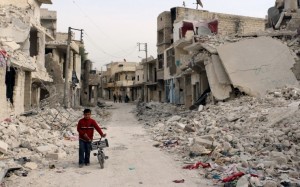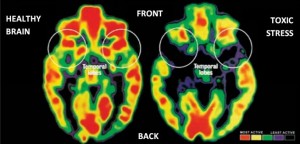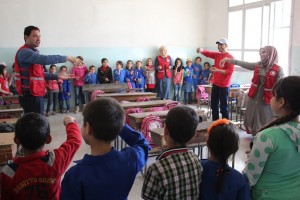Last year, Rosa [Cheesman, EDIT Lab PhD student] wrote about the state of refugees’ mental health in camps, and the factors underpinning resilience to mental health issues as a result of trauma. Continuing the theme, Shivani [Parikh, EDIT Lab placement student] has investigated how the Syrian Civil War might alter children’s development. This article focuses on toxic stress, its effects on the brain and beyond, and treatment interventions.

With a death toll of almost half a million people, the effects of the Syrian Civil War have been unimaginable. The country has been torn apart by countless bombings and airstrikes. The effects of this destruction on food, resources and infrastructure are horrifying it will take decades to recover; but how long will it take for the children in Syria who have grown up in this war to recover, and what kind of life can they be expected to lead?
It is estimated that 7.5 million children have grown up not knowing any other life than of war and conflict. In 2014 it was reported that around 4 million people fled from Syria to seek refuge. Though these people may be physically free from the risk of war, many must still cope with the mental repercussions of growing up in conflict.
Toxic stress is the sustained activation of a stress response over a long period of time (Chu & Harrison, 2007). This is something that millions of children have experienced in Syria, where they have been continually exposed to stressful stimuli for as long as six years with no escape and limited caregiver support. The impact of toxic stress can irreversibly alter the neural connections in young developing brains. Glucocorticoid receptors in the amygdala are overstimulated resulting in consistently elevated levels of stress hormones such as cortisol which can lead to hypertrophy in the amygdala, negatively impacting memory and learning ability.
The effects of these structural changes can reduce tolerance to even mild future stress and can manifest itself as depression and anxiety in the future. Children suffering from toxic stress may have a reduced ability to gain an education as their capacity to learn new things could have been compromised. These effects can go onto have severe economic and social consequences as affected individuals struggle to maintain employment and their anxiety and depression can affect interpersonal relationships (Devakumar et al, 2015).
A Correlation has been found between childhood stress, obesity and addiction in later life (Chu & Harrison, 2007). Individuals who have suffered with toxic stress and subsequently addiction have been found to be less able to provide stable homes for their own children, thus affecting the mental health of future generations. In addition, toxic stress is known to induce cardiovascular disease, cancers and autoimmune diseases.
”…Though these people may be physically free from the risk of war, many must still cope with the mental repercussions of growing up in conflict…”
How can Toxic Stress be treated?
Though it is believed that the effects of toxic stress may be irreversible, early intervention can provide some success. Psychologists and pediatricians have suggested treatments for children suffering with stress, most notably the Relaxation Response. This method works by directly opposing the stress response using techniques such as meditation, yoga, guided imagery and deep breathing. In addition, effectiveness of this treatment relies on the involvement of family members or psychologists to help the child apply relaxation techniques in their daily lives.
”research emphasizes the relevance of personalizing interventions to the specific needs of the individual”
However, children suffering from toxic stress due to the continuous terror of conflict in Syria may not have caregiver support in their lives. Psychosocial support is needed to teach and implement interventions that can help to rehabilitate vulnerable children (Franke, 2014). A primary way of doing this could be through teaching resilience to the affected children (Barnes, 2016). A number of techniques have been suggested to help foster resilience, for example:
- Allowing them to make decisions at school, which can help reinstate a sense of control in their lives.
- Helping them to set realistic goals, which they can work towards thus helping to increase their own self-efficacy.
- Trying to reduce visual and auditory distractors in the environment, which can improve mental capacity.
- Developing a therapeutic relationship with the child to provide them with an outlet to discuss their fears or concerns, which can help them to interpret their own emotions.
- Having a routine, which can provide the child with continuity and security.
This is just a short list of practices that can be implemented to help a child suffering from toxic stress; however research emphasizes the relevance of personalizing interventions to the specific needs of the individual (Franke, 2014). Access to psychosocial support is a necessity for these children, and the only way to increase their chances of leading healthy and stable lives.
If you are interested in finding out about how you can help increase access to resources and psychological care please visit Unicef UK.
References
Barnes, A. .J. (2016). Childhood Stress and Resilience. Health Promotion for Children and Adolescence, 4(4),
Chu, B.C & Harrison, T. L. (2007). Disorder-specific Effects of CBT for Anxious and Depressed Youth: A Meta-analysis of Candidate Mediators of Change. Clinical Child and Family Psychology Review, 10(4), 352-372.
Devakumar et al.. (2015). Child health in Syria: Recognising the Lasting Effects of Warfare on Health. Conflict and Health, 9(34),
Franke, H. .A. (2014). Toxic Stress: Effects, Prevention and Treatment. Children, 1(3), 390-402.



